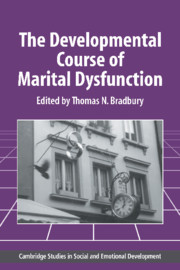Book contents
- Frontmatter
- Contents
- List of Contributors
- Foreword
- Introduction: The Developmental Course of Marital Dysfunction
- Part I Conceptual and Empirical Contributions
- 1 Communication in Early Marriage: Responses to Conflict, Nonverbal Accuracy, and Conversational Patterns
- 2 Marital Aggression, Quality, and Stability in the First Year of Marriage: Findings from the Buffalo Newlywed Study
- 3 Accommodation Processes During the Early Years of Marriage
- 4 The Psychological Infrastructure of Courtship and Marriage: The Role of Personality and Compatibility in Romantic Relationships
- 5 Happiness in Stable Marriages: The Early Years
- 6 Developmental Changes in Marital Satisfaction: A 6-Year Prospective Longitudinal Study of Newlywed Couples
- 7 The Development of Marriage: A 9-Year Perspective
- 8 Premarital Predictors of Relationship Outcomes: A 15-Year Follow-up of the Boston Couples Study
- 9 Optimizing Longitudinal Research for Understanding and Preventing Marital Dysfunction
- 10 Socialization into Marital Roles: Testing a Contextual, Developmental Model of Marital Functioning
- 11 Physical Aggression in Marriage: A Developmental Analysis
- Part II Invited Commentaries
- Author Index
- Subject Index
8 - Premarital Predictors of Relationship Outcomes: A 15-Year Follow-up of the Boston Couples Study
Published online by Cambridge University Press: 13 October 2009
- Frontmatter
- Contents
- List of Contributors
- Foreword
- Introduction: The Developmental Course of Marital Dysfunction
- Part I Conceptual and Empirical Contributions
- 1 Communication in Early Marriage: Responses to Conflict, Nonverbal Accuracy, and Conversational Patterns
- 2 Marital Aggression, Quality, and Stability in the First Year of Marriage: Findings from the Buffalo Newlywed Study
- 3 Accommodation Processes During the Early Years of Marriage
- 4 The Psychological Infrastructure of Courtship and Marriage: The Role of Personality and Compatibility in Romantic Relationships
- 5 Happiness in Stable Marriages: The Early Years
- 6 Developmental Changes in Marital Satisfaction: A 6-Year Prospective Longitudinal Study of Newlywed Couples
- 7 The Development of Marriage: A 9-Year Perspective
- 8 Premarital Predictors of Relationship Outcomes: A 15-Year Follow-up of the Boston Couples Study
- 9 Optimizing Longitudinal Research for Understanding and Preventing Marital Dysfunction
- 10 Socialization into Marital Roles: Testing a Contextual, Developmental Model of Marital Functioning
- 11 Physical Aggression in Marriage: A Developmental Analysis
- Part II Invited Commentaries
- Author Index
- Subject Index
Summary
Selecting a mate is one of life's most important decisions. In our fiercely independent culture, young people place a premium on personal choice in matters of the heart. Unfortunately, current divorce statistics suggest that many Americans are not making good marital choices. At present, empirical research offers few guidelines for detecting which dating relationships are likely to develop into successful marriages. Although there is abundant research on factors such as good looks and attitude similarity that foster initial interpersonal attraction, we know little about the long-term importance of these factors in continuing relationships. There is also a growing literature using information about marital patterns at one point in time to predict later marital success (e.g., Bentler & Newcomb, 1978; Bradbury & Fincham, 1990; Gottman, 1994; Kurdek, 1993). Although such information assists in identifying existing marriages at risk for misery and dissolution, it may not help young lovers to avoid unhappy marriages.
Prospective studies of the premarital predictors of marital success are rare. In a pioneering study, Burgess and Wallin (1953) followed 666 couples from the time of their engagement in the late 1930s to a few years after their marriage. Burgess and Wallin concluded that successful marriage was more likely when individuals had been reared by happily married parents, were self-confident, showed sexual restraint before marriage, had a longer courtship, and endorsed the traditional belief that the husband should be head of the family and the wife should stay home.
- Type
- Chapter
- Information
- The Developmental Course of Marital Dysfunction , pp. 237 - 278Publisher: Cambridge University PressPrint publication year: 1998
- 22
- Cited by



